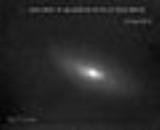
NGC 5005
Encyclopedia
NGC 5005 is an inclined spiral galaxy
in the constellation Canes Venatici
. The galaxy has a relatively bright nucleus and a bright disk that contains multiple dust lanes. The galaxy's high surface brightness makes it an object that is visible to amateur astronomers using large amateur telescopes.
Distance measurements for NGC 5005 vary from 13.7 megaparsecs
(45 million light-year
s) to 34.6 megaparsecs (113 million light-years), averaging about 20 megaparsecs (65 million light-years).
ized gas. The power source for the LINER emission has been debated extensively, with some researchers suggesting that LINERs are powered by active galactic nuclei that contain supermassive black hole
s and other researchers suggesting that LINERs are powered by star formation
activity.
source in its nucleus. These results imply that NGC 5005 contains a supermassive black hole
. The strong, variable X-ray emission is characteristic of the emission expected from the hot, compressed gas in the environment outside a black hole in an active galactic nucleus
.
comprise a physical galaxy pair. The two galaxies weakly influence each other gravitationally, but they are not yet close enough to each other to be distorted by the tidal forces of the gravitational interaction.
Spiral galaxy
A spiral galaxy is a certain kind of galaxy originally described by Edwin Hubble in his 1936 work The Realm of the Nebulae and, as such, forms part of the Hubble sequence. Spiral galaxies consist of a flat, rotating disk containing stars, gas and dust, and a central concentration of stars known as...
in the constellation Canes Venatici
Canes Venatici
Canes Venatici is one of the 88 official modern constellations. It is a small northern constellation that was created by Johannes Hevelius in the 17th century. Its name is Latin for "hunting dogs", and the constellation is often depicted in illustrations as representing the dogs of Boötes the...
. The galaxy has a relatively bright nucleus and a bright disk that contains multiple dust lanes. The galaxy's high surface brightness makes it an object that is visible to amateur astronomers using large amateur telescopes.
Distance measurements for NGC 5005 vary from 13.7 megaparsecs
Parsec
The parsec is a unit of length used in astronomy. It is about 3.26 light-years, or just under 31 trillion kilometres ....
(45 million light-year
Light-year
A light-year, also light year or lightyear is a unit of length, equal to just under 10 trillion kilometres...
s) to 34.6 megaparsecs (113 million light-years), averaging about 20 megaparsecs (65 million light-years).
Nucleus
NGC 5005 contains a low ionization nuclear emission region (LINER) nucleus. LINER nuclei contain weakly ionIon
An ion is an atom or molecule in which the total number of electrons is not equal to the total number of protons, giving it a net positive or negative electrical charge. The name was given by physicist Michael Faraday for the substances that allow a current to pass between electrodes in a...
ized gas. The power source for the LINER emission has been debated extensively, with some researchers suggesting that LINERs are powered by active galactic nuclei that contain supermassive black hole
Supermassive black hole
A supermassive black hole is the largest type of black hole in a galaxy, in the order of hundreds of thousands to billions of solar masses. Most, and possibly all galaxies, including the Milky Way, are believed to contain supermassive black holes at their centers.Supermassive black holes have...
s and other researchers suggesting that LINERs are powered by star formation
Star formation
Star formation is the process by which dense parts of molecular clouds collapse into a ball of plasma to form a star. As a branch of astronomy star formation includes the study of the interstellar medium and giant molecular clouds as precursors to the star formation process and the study of young...
activity.
X-ray emission
X-ray observations of NGC 5005 have revealed that it contains a variable, point-like hard X-rayX-ray
X-radiation is a form of electromagnetic radiation. X-rays have a wavelength in the range of 0.01 to 10 nanometers, corresponding to frequencies in the range 30 petahertz to 30 exahertz and energies in the range 120 eV to 120 keV. They are shorter in wavelength than UV rays and longer than gamma...
source in its nucleus. These results imply that NGC 5005 contains a supermassive black hole
Supermassive black hole
A supermassive black hole is the largest type of black hole in a galaxy, in the order of hundreds of thousands to billions of solar masses. Most, and possibly all galaxies, including the Milky Way, are believed to contain supermassive black holes at their centers.Supermassive black holes have...
. The strong, variable X-ray emission is characteristic of the emission expected from the hot, compressed gas in the environment outside a black hole in an active galactic nucleus
Active galactic nucleus
An active galactic nucleus is a compact region at the centre of a galaxy that has a much higher than normal luminosity over at least some portion, and possibly all, of the electromagnetic spectrum. Such excess emission has been observed in the radio, infrared, optical, ultra-violet, X-ray and...
.
Companion galaxy
NGC 5005 and the nearby spiral galaxy NGC 5033NGC 5033
NGC 5033 is an inclined spiral galaxy located in the constellation Canes Venatici. Distance estimates vary from between 38 to 60 million light years from the Milky Way Galaxy. The galaxy has a very bright nucleus and a relatively faint disk. Significant warping is visible in the southern half of...
comprise a physical galaxy pair. The two galaxies weakly influence each other gravitationally, but they are not yet close enough to each other to be distorted by the tidal forces of the gravitational interaction.

